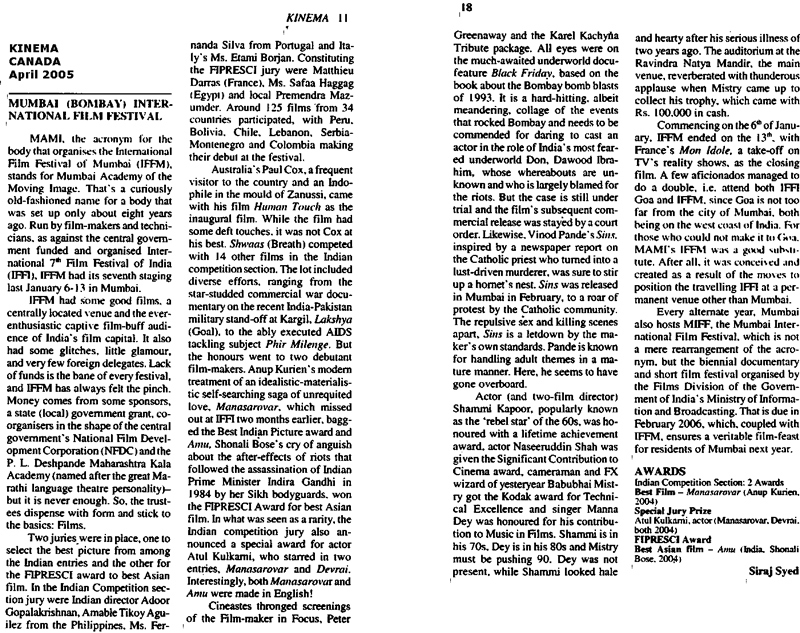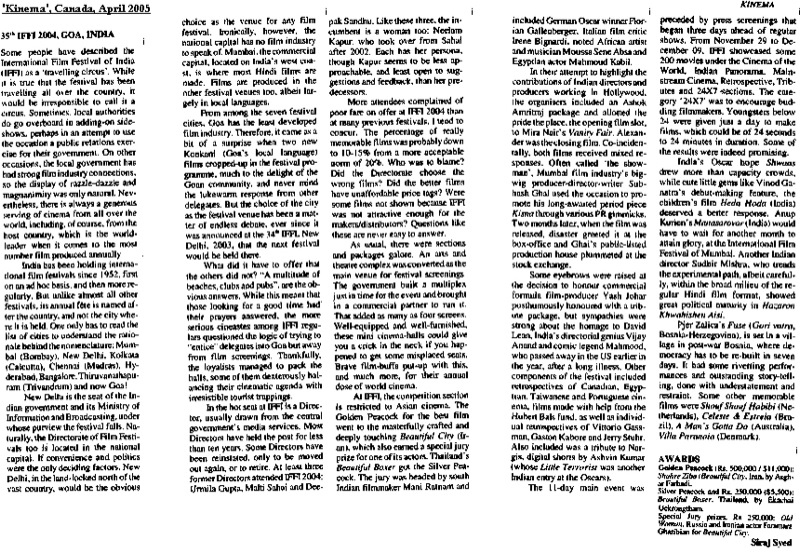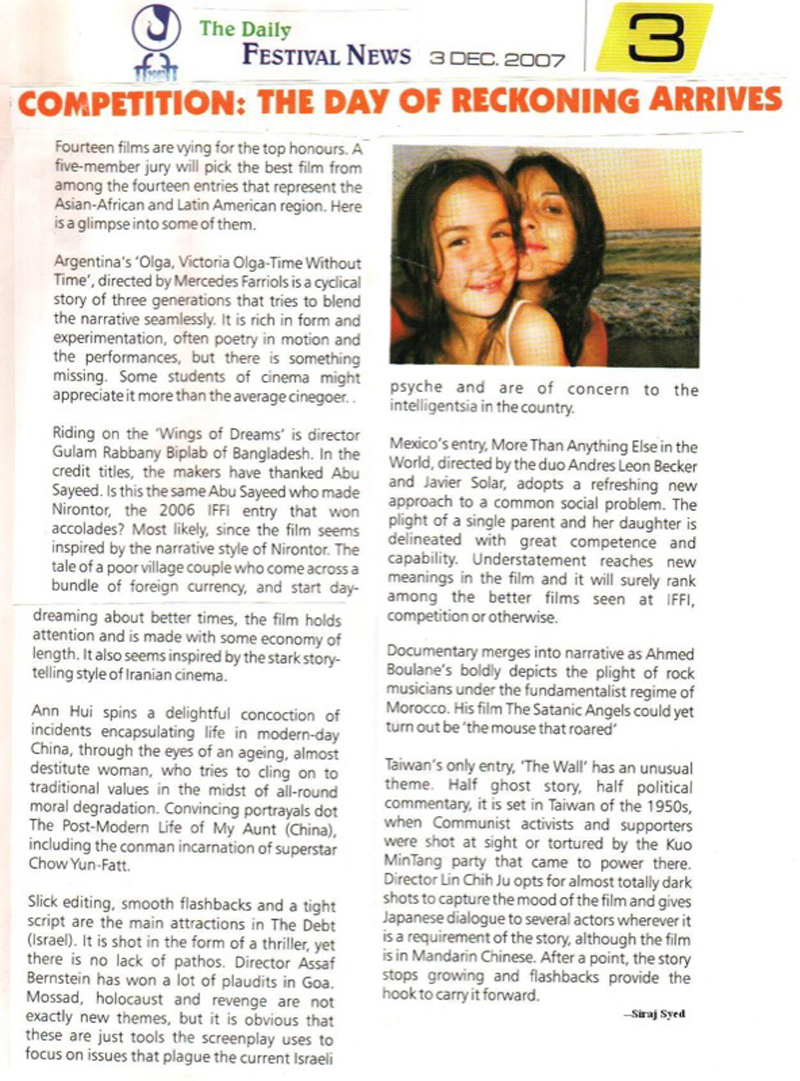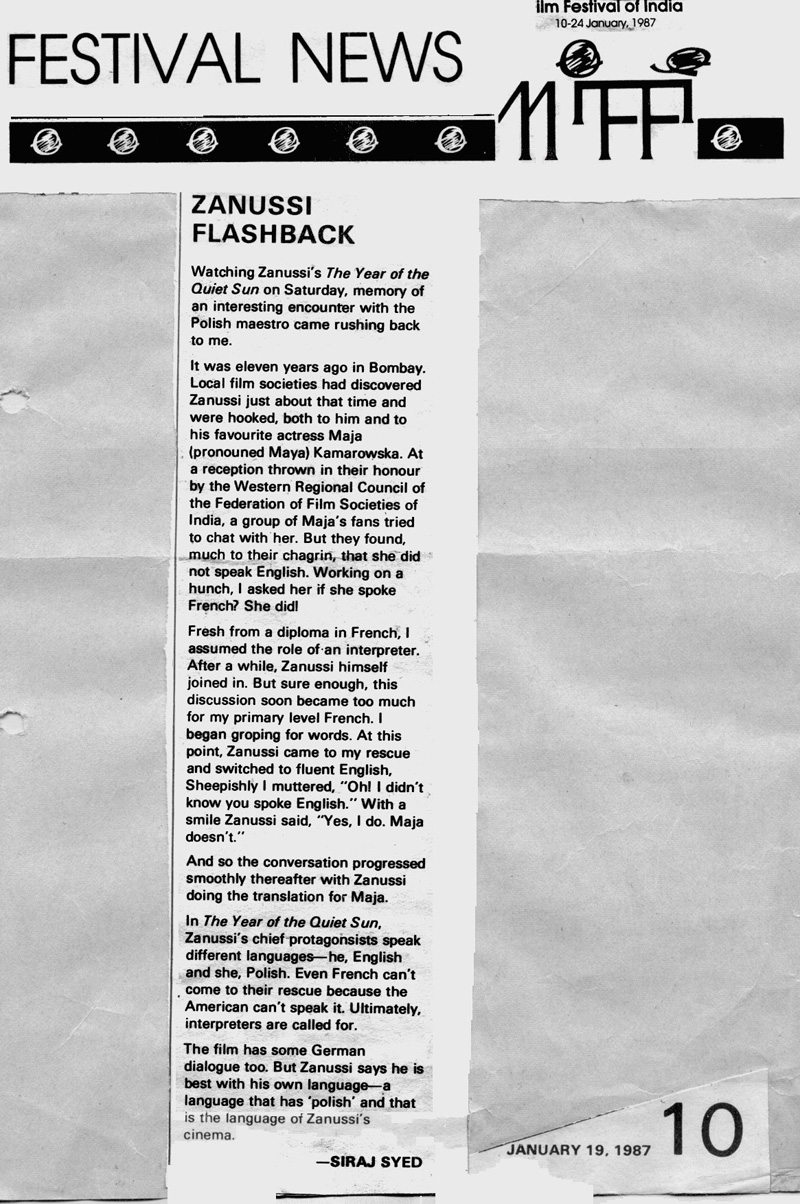|
|
||
|
Pro Tools
FILMFESTIVALS | 24/7 world wide coverageWelcome ! Enjoy the best of both worlds: Film & Festival News, exploring the best of the film festivals community. Launched in 1995, relentlessly connecting films to festivals, documenting and promoting festivals worldwide. Working on an upgrade soon. For collaboration, editorial contributions, or publicity, please send us an email here. User login |
Jhalki, Review: Stop stealing childhood from children
Jhalki, Review: Stop stealing childhood from children After much-raved biopics on Rahul Dev Burman and Jagjit Singh, director Brahmanand S. Siingh trains his lens on an issue that is based on true incidents and is a burning topic for Indian society at large. It brought Kailash Satyarthi the Nobel Peace Prize, and he is both depicted as well as present in the film. How many film-makers can make any such claim? The subject is child-trafficking, and employing little children in carpet factories, as bonded labour. Jhalki is a laudable attempt that must be seen, though it falls short of entering the great cinema club. Ramprasad procures little children from poverty-stricken villages at a nominal price, ships them away to distant towns, and sells them into sweat factories, where they might well end-up working all their life, 14 hours a day. He returns to the same villages time and again, and buys more children. Nine year-old Jhalki is terrified that her parents might sell her seven year-old brother, Babu, who is a sleep-walker, to Ramprasad. She warns him to leave Babu alone. Destiny, however, wills otherwise. Her father gets into a drunken brawl over Ramprasad’s offer to sell Jhalki into child prostitution, and gets severely burnt. To pay for his medical treatment, her mother quietly sells off Babu, while Jhalki is asleep. On waking up, she notices his absence, and immediately runs towards the jetty, where Ramprasad is loading a contingent of eight kids on to a ferry boat. Jhalki jumps in, but that only ends with her being taken away, along with the others, to a small town. There, while Jhalki is deliberately distracted, Babu is smuggled away. Showing remarkable courage, intrepid Jhalki starts tracing the movements of the cycle-rickshaw that carted the kids. The rickshaw-puller admits that he did take the kids to a factory, but warns Jhalki against trying to probe further. She says she would like to meet the King of the place and seek his help, and he leaves her at the gate of the Collector’s mansion. Soon, Jhalki discovers that the police is on the take from the factory owners, but she is overjoyed too, because she has seen a jhalki (glimpse) of Babu, who is working in one the factories. It’s a daunting task, yet Jhalki will leave no stone unturned to reach her brother.
Jhalki is based on a story by Prakash Jha and Brahmanand and has screenplay by Kamlesh Kunti Singh, Brahmanand S. Siingh and Siingh’s long-time associate, Tanvi Jain. Jain and Singh are also among the producers of the film. Before the end credits roll, we are told that Satyarthi rescued over 86,000 children, and Jhalki is inspired by a true incident. Getting a story, therefore, would not have been a very difficult task. It would be a matter of research and culling from so many tales, and then a process of amalgamation and integration. In terms of screenplay, the team gives a nod to Satyajit Ray’s Pather Panchali, by incorporating the little boy and his sister as the protagonists and their fascination for the passing trains in a remote Bengal village. Similar nods, or rather tributes, are made to the almost dead bioscope (nickelodeon) and the art of hand shadow puppetry (done so well by Arko Sen and Amar Sen). Whereas the bioscope tribute remains skeletal, more like a dream or a trance in the beginning of the film, the hand shadow puppetry is displayed in full glory, while Siingh’s own voice-over links it to a fairy-tale, a parable that replicates Jhalki’s plight using a sparrow as the metaphor. She goes from pillar to post to rescue her brother, while the sparrow approaches all animate and inanimate bodies in an effort to retrieve a grain of food that has fallen into a bamboo shoot’s hollow. There might have been some regular animation employed, supporting the puppetry, though it stands on its own merit against any technical wizardry. It will take some believing that Jhalki does what she does without ever having stepped out of her village, which is a tiny hamlet. Her guile, in feigning food poisoning after planting a cockroach in food bought from a sweet vendor in order to blackmail him, pretending to get possessed by Mata Rani (female Goddess) and in giving two lessons to a corrupt Indian Administrative Service officer, belie her background. In addition, she pulls him up for accepting a bribe, whereas a girl so young, not exposed to town/city life, might not even understand the concept of bribery, even while seeing it in action. Also, on two or three occasions, she is able to out-run her predators almost comfortably. Agreed that village kids might be no strangers to running fast, such recurring instances, nevertheless, do appear incredible. Over several days, Jhalki roams the streets and sleeps on the road. Only once is she kidnapped, but the ease with which she escapes appears to be too convenient. After dropping some hints, the writers then go on to expose the whole racket, and the criminal-police-judiciary nexus, warts and all, going the whole hog. That is commendable, though the raids are repetitive. Also commendable is the dialect spoken by most of the characters. The only positive characters in the town turn out to be the Collector’s wife (shades of grey) and a TV journalist, a woman. Guess Brahmanand owes it to the fourth estate, having worked as a journalist for many years, before he jumped over to the other side! Rahim Chacha (a clichéd name; so many Muslims with beards have been called by that moniker!), the rickshaw-puller does ferry children to their doom, but has qualms about it, and confides in the journalist, so he can be counted among the greys. A silent look often conveys a lot, and Siingh uses it to good effect on the faces of the Collector’s wife and the rickshaw puller. Dreams and flashbacks/memories are neatly interwoven. Siingh has made a disturbing film, while doing yeoman’s service to a cause that can never be taken seriously enough, one that he justifiably feels should be talked about after the film is over, the film itself serving as an impetus to create more Jhalkis. Singh has even hired four ‘impact managers’ who will work towards sustaining interest in the film and its cause, among those who see it. Might be a first, and we will be keen to see the results, the impact of impact managers. As Kailash Satyarthi says on screen at the end, it is a grave crime to take away a child’s childhood and independence from him. Who, in his or her right mind, will disagree? As the Collector and District Magistrate, Sanjay Suri is mechanical and unable to intonate the dialogue with effect. Divya Dutta acts well, her only drawback being her speaking voice. Tannishtha Chatterjee is effective as the journalist, perhaps a bit naïve in her initial scenes. No fault of hers, though. Govind Namdev, though type-cast as the limping, drinking villain, keeps in character, without managing the dialect too well. Yatin Karyekar plays the bioscopewala, an inconsequential and vague role. As Suri’s assistant, Joy Sengupta does a decent job. Boman Irani fails to impress as Kailash Satyarthi, probably more so because soon after his role is over, we have the real, eloquent, smooth Satyarthi on screen. Akhilendra Mishra as the sweat-shop operator and paedophile fits the bill, both physically and linguistically. The actors playing the children’s parents, the rickshaw puller and the sweet-shop owner deserve honourable mention. That leaves the two scene stealers: Aarti Jha and Goraksha Sakpal, as Jhalki and Babu. They look 7 and 5, rather than 9 and 7, which is acceptable, what with the poverty and malnutrition they live in. Both show no camera-consciousness. Goraksha, on the contrary, seems to enjoy the attention. Appreciable contributions come from Sandesh Shandilya, who has scored the music, cinematographer Rupesh Kumar and editor Suresh Pai. Shandilya has a really hummable track in the sparrow song. Kumar uses some imaginative angles and shadows, including one that shows several thick criss-crossing wires high above. Pai often cuts in the question-answer format—raising a question, cutting on to the face of the person who might have the answer, but answering in a jump cut, with action, not words. Of course, all this could be the already imagined ideas of Siingh and Jain. One scene shows Jhalki almost drowning, and is cut when her hand is about to go underwater. But of course, you know that Jhalki cannot die in the first quarter of a 119 minute film called Jhalki. To coincide with India’s Children’s Day, November 14, which happens to be the birthday of Jawaharlal Nehru, the release of the film will take place on a Thursday, instead of the normal Friday. Do catch it in cinemas. It may not be the best film in recent times but it definitely has glimpses of greatness. And don’t forget the cause it espouses, with its heart in the right place. Rating: *** Trailer: https://www.youtube.com/watch?v=IfUDldD0zow 12.11.2019 | Siraj Syed's blog Cat. : Aarti Jha Akhilendra Mishra Amar Sen Arko Sen bioscope Brahmanand S. Siingh Divya Dutta Goraksha Govind Namdev Joy Sengupta Kamlesh Kunti Singh Karyekar nickelodeon Prakash Jha Rupesh Kumar Sandesh Shandilya Sanjay Suri Suresh Pai Tannishtha Chatterjee Tanvi Jain Independent FILM
|
LinksThe Bulletin Board > The Bulletin Board Blog Following News Interview with IFTA Chairman (AFM)
Interview with Cannes Marche du Film Director
Filmfestivals.com dailies live coverage from > Live from India
Useful links for the indies: > Big files transfer
+ SUBSCRIBE to the weekly Newsletter Deals+ Special offers and discounts from filmfestivals.com Selected fun offers
> Bonus Casino
User imagesAbout Siraj Syed Syed Siraj Syed Siraj (Siraj Associates) Siraj Syed is a film-critic since 1970 and a Former President of the Freelance Film Journalists' Combine of India.He is the India Correspondent of FilmFestivals.com and a member of FIPRESCI, the international Federation of Film Critics, Munich, GermanySiraj Syed has contributed over 1,015 articles on cinema, international film festivals, conventions, exhibitions, etc., most recently, at IFFI (Goa), MIFF (Mumbai), MFF/MAMI (Mumbai) and CommunicAsia (Singapore). He often edits film festival daily bulletins.He is also an actor and a dubbing artiste. Further, he has been teaching media, acting and dubbing at over 30 institutes in India and Singapore, since 1984.View my profile Send me a message The EditorUser contributions |





























